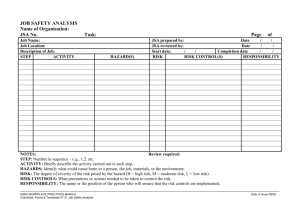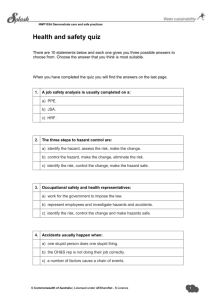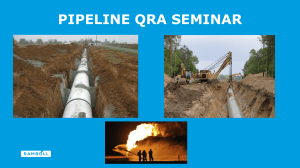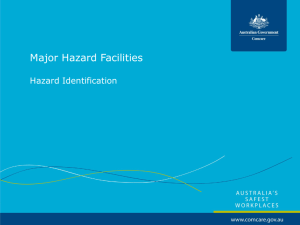Risk Analysis & HAZID
advertisement
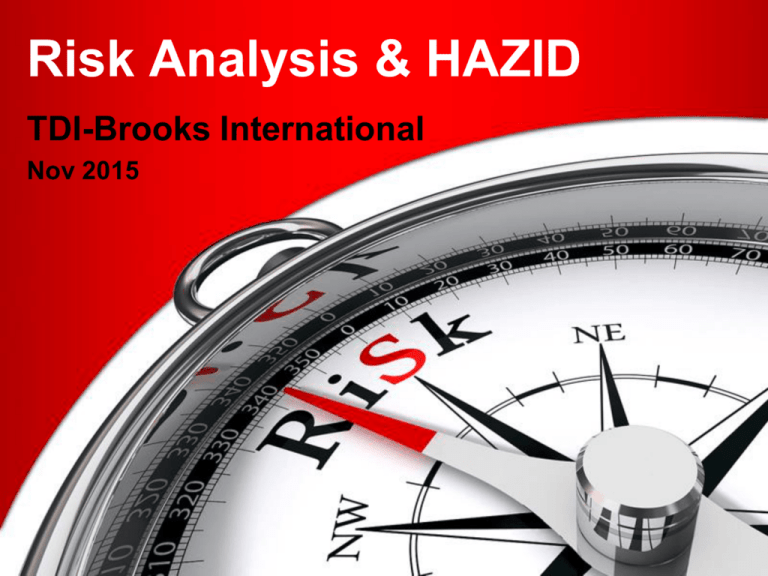
Risk Analysis & HAZID TDI-Brooks International Nov 2015 Situational Awareness • You are exposed to dangers every day– but do you recognize them? Situational Awareness So many people get injured because they are not paying attention to where they walk that cities have had to “idiot proof” common obstacles. Situational Awareness You work offshore on a moving vessel in all types of weather. How much more dangerous is your job? Analyze the Risk Before beginning any task, you need to STOP and analyze the risks. Hazard or Risk? • Hazard is any potential for harm (to yourself, environment or equipment) • Risk = Hazard + Exposure • If there is no exposure, then there is no risk. Likelihood vs. Severity Risks are rated by likelihood (probability) and severity of the potential consequences. Analyzing Risk • The ship’s cook is exposed to heat & steam every day as part of his job. Analyzing Risk • The process of cooking anything will involve the production of steam and heat. (hazards) • The cook has to be near the steam and heat to prepare the food. (exposure) • Hazard is mitigated by using oven gloves. Heat & Steam Exposure • Frequent exposure to heat and steam at low levels and with mitigations (oven gloves) is acceptable. Heat & Steam Exposure Very Likely + Low severity + Mitigations= Acceptable risk Analyzing Risk • The radiator of a car also contains heat and steam. (hazard) • But that heat and steam is under pressure and contained in the radiator. (no exposure) • Hazard - Exposure = No Risk But what will happen if you try to open a hot radiator? Exposure to a severe hazard This man tried to hit the radiator release valve on a hot engine with his bare hands. Heat & Steam Exposure • A single exposure to pressurized heat and steam from a hot radiator is very harmful. Unacceptable risk To lower to acceptable risk, use mitigations Mitigations• Wait until radiator cools • Use heat protective gloves when opening Radiation Exposure • Daily exposure (likely) to high level radiation is very harmful. (major) Welders are exposed to high levels of hazardous UV light produced by electric arcs every time they work. Radiation Exposure Very Likely + Severe = Unacceptable risk Radiation Exposure • Extreme risk is unacceptable. • The risk must be reduced to an acceptable level How to Reduce the Risk? To reduce risk, you have to reduce the probability or the severity. A welder must be exposed to the hazard of UV radiation in order to work. Removing the exposure is not an option. How to Reduce the Risk? • Reducing the exposure is an option A welding hood significantly reduces the amount of UV radiation that reaches the eyes. Hazard Identification (HAZID) • Before starting a job, TDI-Brooks works with the client to develop a Hazard Identification or HAZID. • A sample HAZID is in the SMM Chapter 14. What a HAZID Analyzes • The standard HAZID reviews all the potential risks associated with planning and executing the project. • The HAZID is a review of the BIG PICTURE– or the project as a whole. What a HAZID Analyzes • It also lists mitigations for every hazard from travelling to the boat, to how samples are collected, required PPE and what to do in case of an oil spill or MEDEVAC. Job Safety Analysis (JSA) • Risk for specific tasks are assessed in the form of a Job Safety Analysis or JSA. • It is a smaller version of the HAZID: – JSA lists the steps to complete the task – JSA lists the risks related to each step – JSA lists the PPE, procedures and other mitigations to minimize those risks JSAs on Crewing Module Templates for survey and coring activities JSAs are on the Crewing Module just under the boat name. JSAs in Permit Work For any work requiring a permit, the JSA is integrated into the permit. JSAs For Non Permit Work For work that does not require a permit, there is a blank JSA template on the ship web pages. Review JSAs Every Time Review the JSA every time before you do that task. Situations or conditions may have changed. STOP WORK Authority ANY employee, regardless of position or experience with the company, is empowered, encouraged and expected to STOP WORK if he feels anything is unsafe, or if he is unsure of his role/ responsibilities regarding an operation. PPE Matrix • The PPE matrix tells you what PPE is required for common tasks. PPE • The JSA team will determine what is needed for a specific task. STOP WORK Situations Someone not wearing correct PPE or not wearing it correctly? STOP WORK STOP WORK Situations Someone putting themselves at obvious risk? STOP WORK STOP WORK Situations Someone not following procedures? STOP WORK Last Minute Risk Assessment • TDI has a Last Minute Risk Assessment (LMRA) • Just before you begin to work, ask yourself these 5 questions: • • • • • Has anything CHANGED? What HAZARDS will I face? Am I following PROCEDURES? Wearing proper PPE? How will I stay safe? Questions? ???
